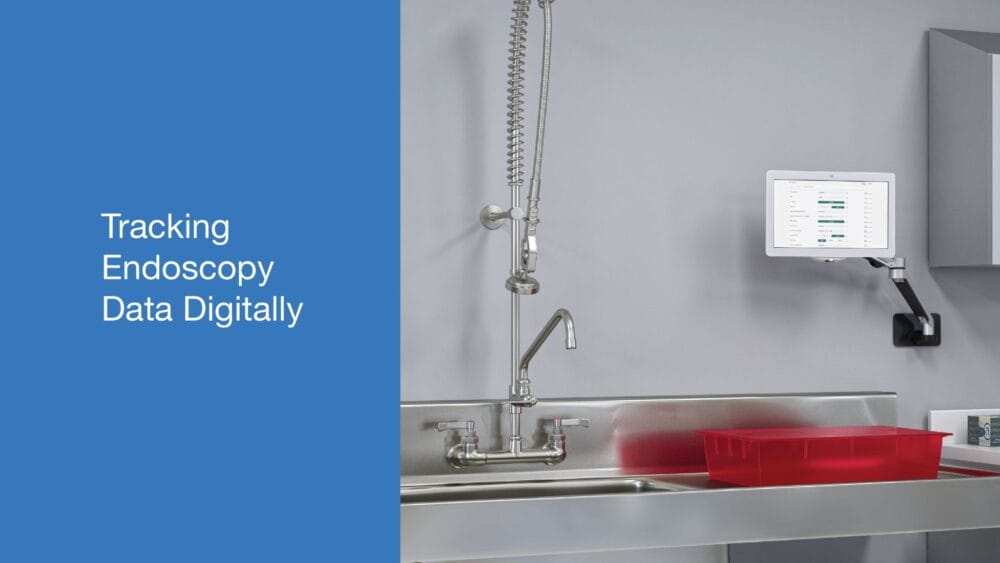
Is it time to invest in a system that gathers and organizes your endoscopy department’s data, saving time and ensuring audit-ready documentation?
Endoscopy units still using pen and paper risk illegible logbook entries and incomplete records.
Your healthcare facility can save time and money by investing in a system that identifies missed steps during endoscope reprocessing and keeps staff accountable. Consider using a robust data tracking system to boost your department’s efficiency, act as a measuring stick for policies and procedures, and add to your infection control arsenal.
Here are the top 6 benefits of utilizing a digital logbook when tracking endoscopy data to improve management of endoscope records.
Increased Patient Safety
Medical research shows that controlling the spread of infectious organisms during endoscopy procedures is challenging. While endoscopy-associated infection (EAI) rates are difficult to calculate, the World Journal of Gastroenterology reported that most EAI are due to inadequate reprocessing.
Endoscope reprocessing requires a staggering number of steps, as many as 100. Endoscopy units should standardize their processes to align with industry guidelines. One missed step during reprocessing can result in the development of sticky biofilm within endoscopic channels. These colonies of microorganisms are hard to remove and can transmit infectious material to the next patient.
Digital documentation and tracking can help detect a skipped step. Among other important details, tracking endoscopy data includes the storage of each cleaning solution lot number for patient safety and uses the barcode scanner to accurately record data.
Templates built into a digital logbook allow managers to customize the protocols and workflow of your facility’s endoscopy unit.
Increased Efficiency
Tracking endoscopy data helps you identify trouble spots during reprocessing by tracking start and end times of each reprocessing step. You can then rectify discrepancies and update procedures by taking a proactive approach to process issues.
For example, discrepancies might include:
- Variances in the time it takes different technicians to complete the reprocessing
- Delays between steps creating frequent repeat reprocessing
Noticing these variations may indicate the need for retraining.
A digital logbook provides the data needed to solve minor issues before an auditor arrives. Being proactive saves time and money. Instead of scrambling at the last minute to clean up documentation and rewrite illegible entries, a logbook makes it easy to pull the information needed for an audit.
Extend Scope Life and Eliminate Manual Scope Checks
The lifetime of the scope before its next reprocessing can be fully utilized by placing digital logbooks in clinical areas. Staff can quickly determine which scopes are nearing their hang time limit and pull these scopes first. This helps limit the need to reprocess clean scopes.
Furthermore, instead of manually checking each scope for maintenance needs, a digital logbook can proactively notify managers when a scope has reached the end of its hang time.
Real-time notifications ensure that expired scopes are not inadvertently pulled for use, which is a potential infection risk for patients.
Thus, using the latest technology in tracking endoscopy data can both extend the life of each scope before reprocessing is required and eliminate the need for manual scope checks each time a scope is needed for use.
Timely Internal Audits
Logbooks provide weekly activity reports that can help managers search for trends, such as scopes associated with frequent infection reports or those needing repairs. This is invaluable information when it comes to internal audits.
Processes for tracking endoscope data make it easy for staff to record required data. Digital logbooks equipped with custom templates ease the burden of recording procedure type, date, provider, reprocessing technician, time stamps, endoscope and sterilizer serial numbers, and lot number and type of disinfectant.
Armed with this historical information, internal audits can help managers identify areas of concern and to problem-solve. Is it time to review and revise policies and procedures based on the data? Is the training of reprocessing technicians adequate? Where can you improve?
Audit-Ready Digital Documentation
Real-time documentation as scopes proceed through the reprocessing steps ensures that your records are up-to-date. Populate compliance-ready templates for efficient audits.
Faster Infection Control Response Times
A thorough digital record of each endoscope can eliminate the need to wade through boxes of paper logbooks when the infection control department calls to request information for an infection control root cause analysis.
Place digital logbooks where staff can scan and chart as they work. Documentation in real time reduces the risk of errors.
During an infectious disease investigation, the unit can quickly provide the requested data. The logbook provides infection control data, such as a report of the history of the scope, patient identifiers, providers, reprocessing, technicians, and hang times.
The InnerSpace Ventaire Endoscopy System pairs with a new logbook workstation that tracks scope cleaning and storage. Workstations can be mounted on a wall or attached to a countertop base for easy access. Contact InnerSpace to discuss how the Ventaire Endoscopy System with Logbook can help your endoscopy department operate more efficiently.

Cindy Blye
Content WriterCindy Blye, BSN, RN, CCM is a Registered Nurse and Certified Case Manager. She is an Alumni of West Virginia University School of Nursing (BSN), and a member of the Association of Health Care Journalists and The Authors Guild.
